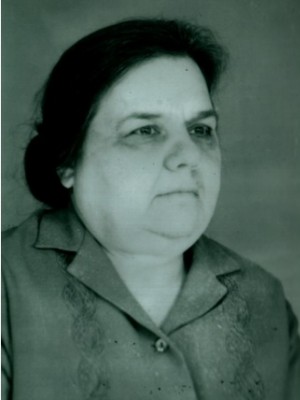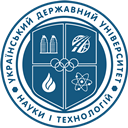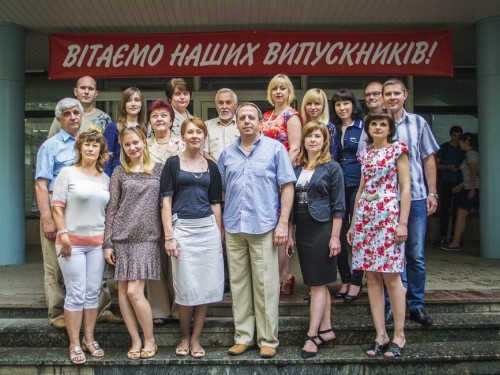DEPARTMENT OF NATURAL AND SYNTHETIC POLYMERS, FATS AND FOOD PRODUCTS

Nina Kostiantynivna Moshchinska (1912-1991) d.ch.s. professor, head of the Department (1955-1975) contributed to the development of Soviet polymer chemistry.
The ever-increasing need for defense industries and the economy in new light and durable materials in the middle
In the distant 50s of the last century, the history of all polymeric chemistry at the time of Soviet Ukraine was closely intertwined with the name of Nina Kostiantynivna Moshchinska. She was born in Arkhangelsk city. She graduated from the Kyiv Polytechnic Institute in 1934. After graduating from the Institute, she worked in the research department of semi-finished products and dyes of the central factory laboratory of the chemical plant in Rubizhne, where he carried out a large cycle of research on the development and introduction of the technology for the production of hydroxynaphthoic acids, dibenzipreninhin, indentrenum, dyes, cobalt golden-yellow and other dyes and products that were at that time the main products of the “Dye”. In 1940, N.K. Moshchinska moved to position of the teacher to the Rubezhansky chemical-technological institute where she worked as an assistant of the chair of organic chemistry, intermediates and dyes. In 1941, together with the institute, she was evacuated to the city of Kemerovo, after the liberation of the Donbas in 1943, she returned to Rubizhne, where she continued his teaching and work on a Ph.D. dissertation devoted to the synthesis of a number of intermediates for dyes.
After defending the dissertation at the Moscow Chemical Technology Institute after D.I. Mendeleev in 1944, Nina Konstantinovna headed the department of semi-finished products and dyes of the Rubezhansky chemical-technological institute.
After the closure of the RCTh in 1949, Nina worked briefly in the Korean People’s Democratic Republic, and then was sent to the Dnipropetrovsk Chemical Technology Institute, where she worked as an associate professor of the Department of Technology for Basic Organic Synthesis, dean of the Faculty of Technology of Organic Substances. From 1952 to 1954, under the guidance of Professor MM Vorozhtsov (MCTII), she was engaged in research of processes of condensation of aromatic hydrocarbons with formaldehyde. In April 1955, she defended her doctoral dissertation “Research in a number of diarylmetals and their derivatives”.
With its active participation in December 1955, the Department of Technology of Plastic Masses was founded (from it in 1991 the department of KhTVMS was allocated), which was headed up to 1975, and later the Problem Laboratory of Synthetic Polymers and Intermediates was created. In 1957 he was approved by a scientist called the professor of the founded department.
The staff of the department (then Technologies of plastics) in 1972
From left to right: Gorbunov O.V., Malovychko MS, Sokolenko V.M., Ogiy M.S., Kravtsov V.С., Ivanov B.М., Budinska N.N., Moschyns’ka N.K. Kozopolyansky MS, Zhupiev LI, Rakova T.A., Kislitsina Z.G., Steba SS, Chertok Ye.R.
From the day of the existence of the Department, there was a scientific school of Professor N.K. Moshchinska, dedicated to the synthesis of monomers, polymers and plasticizers on the basis of aromatic hydrocarbons – products of coke production.
The distribution of the method for the preparation of diphenylmethane and other hydrocarbons led to the development of technological processes for the production of ditholylmethane, dicksilylmethane and a number of other hydrocarbons, which with some variants are now used everywhere for the synthesis of diarylmethane. Further possibilities of this synthesis are shown by N.K. Moshchinskaya and his colleagues in the study of the reactions of the formation of asymmetric diarylmetals and other derivatives by condensation of formaldehyde with two different hydrocarbons or their derivatives.
Much of studies of N.K. Moshchinska was devoted to the synthesis of oxygen-containing products, the condensation of formaldehyde with hydrocarbons. With its participation the influence of the synthesis conditions on the outguns of formaldehyde resins (formolites), the content of oxygen in them and individual groups of atoms was determined, the investigation of formation reactions of formolites was carried out using as model compounds of benzyl alcohol, dibenzyl ether, dibenzylformal, obtained crystalline polymers of a number polyarylmethylenes, as well as analogues of formolites: ethers of dimethylolaranes and poly-p-xylenol polyformals.
The most practical application was the reaction of formolites with phenol, which resulted in the formation of arfinogen-formaldehyde resins whose properties depend on the nature and amount of acid catalyst, the ratio between hydrocarbon-formaldehyde resin and phenol, the nature and composition of the formolite itself. Formulates derived from toluene, xylenes, ethylbenzene, naphthalene, acenaphthene, phenatrene, fluorene, fluoranthren and mixtures thereof were used to synthesize arfenol formaldehyde resins. Based on these resins, structural materials were obtained under the name of the aroplast F.
In most cases, their dielectric properties, alkali resistance, hardness, heat resistance, as well as coke content exceed the similar properties of phenoplast.
Under the leadership of N.K. Moshchinska by condensation of bischloromethylarenes with phenol was developed a method of synthesizing arsenic of phenol-formaldehyde resins.
These resins are different from the resins obtained by condensation of formolites with phenol, a more regular structure and more reactive end phenolic groups. Also, phenol reactions with products of deep chlorination of xylyl chlorides, xylenes and diarylmetals were carried out, with the formation of resins in which the hydrocarbon skeleton is framed by oxyphenyl groups.
Of the compounds containing trichloromethyl groups, derivatives of quinone-amides are formed, which by conversion can be converted into polyphenols. The resulting oligomers are readily cured by urotropin and can be used to make compression materials like phenol.
Much of the works of N.K. Moshchinska and her colleagues were devoted to the synthesis of epoxy resins based on the products of condensation of bischloromethylarenes, polychlorinated derivatives and formolites with phenol, which are characterized by a lower cost compared with epoxidian resins.
On the basis of these materials materials with increased parameters of heat resistance and impact strength are obtained. Monoglycidyl derivatives of oxidarylmethane (obtained by condensation of phenol with arylchloromethane) are used as polyvinylchloride stabilizers and plasticizers and active thinners of epoxy resins.
Chloromethyl derivatives of aromatic hydrocarbons have been widely used. Thus, with the interaction of bischloromethylarenes with tertiary diamonds, quaternary ammonium salts – ionenes are obtained.
When interactions of chloromethyl derivatives with tertiary amines form quaternary ammonium salts, which produce complex compounds with Lewis acids. They are effective catalysts for diarylmethane condensation and accelerators for curing epoxy resins. Complex catalysts are introduced in the industrial production of plasticizer TNM, phosphorus-containing antipyreans, in the production of fiberglass and fluting compounds based on epoxy resins.
N.K. Moshchinska is the author of more than 300 printed works and many inventions. Under her leadership 40 candidate dissertations were completed and defended. As a result of the research, a monograph “Polymeric materials based on aromatic hydrocarbons and formaldehyde” was published.
From 1975 to 1986, the Department was headed by the doctor of chemistry, professor Yu.V. Svetkin, who opened in 1977 another specialty “Technology of wood-based panels and plastics“. In the same year, a new department appeared from the department – “Department of processing plastic masses and film materials“. In 1985, the branch scientific research laboratory for modification of wood materials was opened at the Department, which was headed by the doctor of chemical sciences, professor M.Ya. Kuzmenko. In 1991, the Department received a new name – “Department of Chemical Technology of High-Molecular Compounds“.
From 1988 to 2005, the Department was headed by the doctor of chemistry, professor I.V. Koval, under whose direction the main direction of scientific activity was the development of methods for the synthesis of new hetero-functional monomers and polymers. Since 1996, there appeared a new specialty “Technology of fats and fat substitutes”.
At present, the Department is headed by Doctor of Technical Sciences O. V. Chervakov. The main direction of scientific activity is carrying out of fundamental and applied works on the development of methods of synthesis of new ionogenic, organic and organometallic polymers, as well as the creation on their basis of polymeric materials with practical properties: adhesives, coatings, ion exchange and ion-conducting materials, binders and modifiers additives for composite and paint and varnish materials. The new direction of the department is the development of technologies for the synthesis of biofuels, solvents, modifiers of polymer compositions derived from fatty raw materials of plant and animal origin.
The staff of the Department at present
Over 5500 specialists have been trained by the Department, about 70 candidate and 7 doctoral dissertations have been defended.
Among the graduates of the Department are well-known scientists and heads of organizations:
- Director of the Institute of Bioorganic Chemistry and Petrochemistry of the National Academy of Sciences of Ukraine, Academician VPKukhar;
- Rector of SHEI USUCT, professor M.V. Burmistr;
- Laureate of the State Prize of the USSR, Member of the National Academy of Sciences of Ukraine V.V. Shevchenko;
- professors AMKarateev, B.A.Rozenberg, F.G. Fabuliak;
- Laureate of the State Prize of Ukraine Yu.R. Kolesnik and others.


